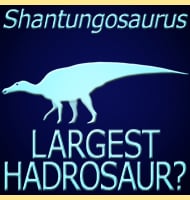In Depth
Platypterygius was a medium sized ichthyosaur that lived towards the end of the reign of this group of marine reptiles. The name which means ‘flat wing’ seems to have been in reference to the arrangement of the bones inside the front flippers which were tightly bound to produce the flat form. This feature may have been to reduce water resistance experienced by Platypterygius while swimming. As a group the later ichthyosaurs developed ever more streamlined and powerful swimming bodies in the face of increasing competition from other oceanic predators such as marine reptiles like the plesiosaurs, sharks and bony fish.
The wealth of fossil material associated with Platypterygius has helped prove the theory that ichthyosaurs gave birth to live young at sea. This comes from the remains of pregnant females as well as new born pups that were born tail first so that pup did not drown while it was being passed out of its mother’s body. This has always been thought plausible for the ichthyosaurs because their body form would make it seemingly impossible to lay eggs on land, and live birth may have been developed by other groups of marine reptiles such as the plesiosaurs and pliosaurs.
Fossils of Platypterygius are known from almost every major continent on the planet, and with further material that possibly extends the geographic range of the genus even further it seems that Platypterygius may have had what is called a cosmopolitan distribution. Despite this Platypterygius is often associated with Australia because of the large number of remains for this genus which have been recovered from there. It might seem strange that a marine reptile like Platypterygius would be found in inland regions of this continent but back in the Cretaceous period Platypterygius could have gained access to these parts via the Eromanga Sea, a shallow Cretaceous sea that once submerged much of inland Australia. This sea resulted in the Australia of the Cretaceous looking more like a group of islands rather than a single continental landmass.
Further Reading
– A new genus of ichthyosaurs from the Late Cretaceous of the Ulyanovsk Volga region. – Paleontological Journal 4:77-82 – V. M. Efimov – 1997. – Platypterygius sachicarum (Reptilia, Ichthyosauria) nueva especie del Cret�cico de Colombia – Revista Ingeominas 6, 1997: 1–12 – M. E. P�ramo – 1997. – On ichthyosaur remains from the Cretaceous of the Voronezh region – Paleontological Journal, v. 42, n. 3, p. 287-291. – M. S. Arkhangel’sky, A. O. Averianov, E. M. Pervushov, Ratnikov, V. Yu & N. Yu. Zozyrev – 2008. – An ichthyosaurian forefin from the Lower Cretaceous Zapata Formation of southern Chile: implications for morphological variability within Platypterygius. – Palaeoclimate, Palaeobiology, Paleoenvironments. 92 (2): 287–294. – Judith Pardo-P�rez, Eberhard Frey, Wolfgang Stinnesbeck, Marta S. Fernandez, Luis Rivas, Christian Salazar & Marcelo Leppe – 2012. – Taxonomy of Platypterygius campylodon and the diversity of the last ichthyosaurs. – PeerJ. 4: e2604. – V. Fischer – 2016.










